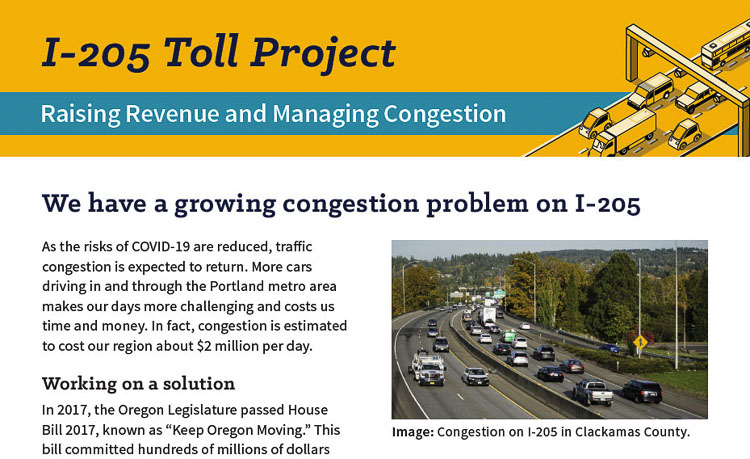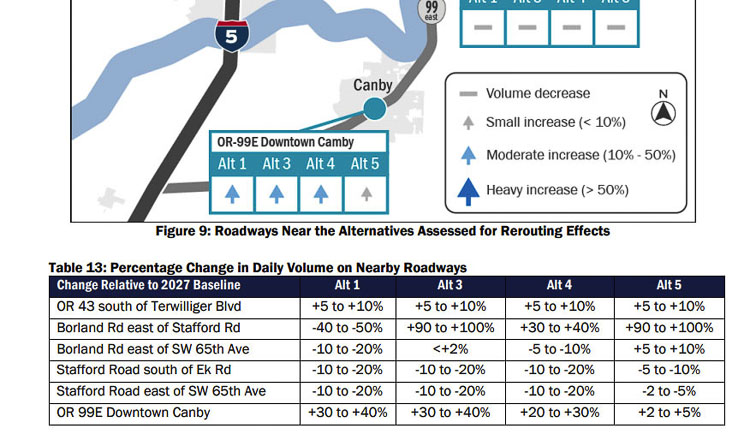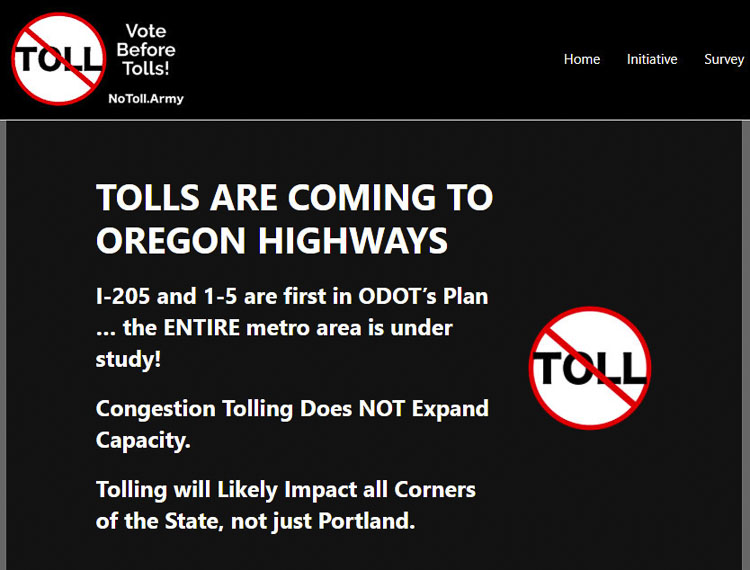IP-41 would allow citizens to vote on a tolling project prior to implementation
Last week, many area citizens were thrilled to hear news reports indicating the Oregon State Department of Transportation (ODOT) officials had hit the “pause” button on I-205 tolling. ODOT’s Tia Williams reports that is not true. The program continues to move forward, as ODOT officials say the agency needs the money to pay for the project.
Due to the fact that more than 70,000 Clark County drivers commute to Oregon to work each week, this first step in Oregon’s efforts to toll drivers on both I-205 and I-5 has obvious future impacts on Southwest Washington residents.
Williams works in ODOT’s Urban Mobility office and shared what actually happened was a one-month delay in an upcoming discussion and vote on tolling for I-205. There are three different organizations needing to approve the tolling program at Metro – JPACT for transportation, MPAC for land use, and the Metro Council.
A request was made by Clackamas County Commissioner Paul Savas, to delay the vote and to have more information presented, according to one news report. ODOT is proposing to amend the Metro region’s long-term transportation plan and its required process for allocating funding to transportation projects.

Williams provided the following information via email.
“While a set of Metro RTP (Regional Transportation Plan) amendment votes have been pushed out a month, ODOT has not delayed or postponed any work on either the I-205 tolling project or the Regional Mobility Pricing Project, nor have we delayed our decision to toll. Tolls are needed to complete construction of the I-205 improvements project, regardless of whether or not additional federal funds are secured. In part, that’s because tolls are a necessary financing mechanism for this project, but tolls will also be an ongoing congestion management tool that we use throughout the region.
We are continuing to engage with partner agencies and local governments, like Clackamas County, in developing the program and advancing it through the planning stages. A critical component of this process is answering questions and addressing concerns as we work to implement a program that serves everyone who depends on having access to a safe and efficient transportation system.”
The I-205 project
The Oregon State Legislature was originally told the cost of the I-205 Abernethy Bridge project was $452 million, which the legislature used in passing HB 2017 (in 2017). Less than a year later, ODOT updated the information and the cost increased to $500 million. ODOT staff had failed to include inflation estimates in what they shared with the legislature, which added $56 million.
Doing a seismic upgrade to the Abernethy Bridge and adding a new lane in each direction was projected to cost $248 million. The second phase, adding one new lane in each direction on I-205 from the bridge to Stafford Road (7 miles) was estimated to cost $197 million.
By the fall of 2021, the cost estimates climbed to $700 million for the project. That’s a 55 percent increase in what the legislature agreed to fund, before a shovel has even turned. Reports indicate over 100,000 vehicles travel that section of I-205 on an average day.
Problems estimating costs by ODOT is not unique to the I-205 project. The current Rose Quarter project on I-5 is approaching triple the original estimated cost. The “highway cover” over I-5 and “equity” issues tied to the Albina neighborhood have increased the cost estimates to roughly $1.25 billion from the original $450 million.
ODOT reported “There is a 30-percent chance that a magnitude 8 or greater earthquake will occur in Oregon within the next 50 years. Transportation infrastructure resilience is one of the primary components required for an effective recovery following this significant natural disaster. In the event of the earthquake, this route may be the only connection between Oregon and Washington. ODOT designated I-205 as a Phase 1 statewide north-south lifeline route, which means it must be operational quickly after a disaster renders other roadways unusable or impassable. This critical route will provide supplies and services to the region.”
Clackamas County Town Hall
In early December, the Clackamas County Commissioners held a citizen town hall to allow citizens to weigh in with their concerns regarding ODOT’s specific I-205 tolling plans. The meeting ran for over 90 minutes and as Chair Tootie Smith noted at the end, not a single person spoke in favor of the tolls. Both residents and commissioners pushed back against ODOT.
“This is a punitive tax,” said Charlie Dudley, a Donald (Oregon) resident. “A toll is a punitive tax. It’s a regressive tax, regardless how anyone wants to frame this, and we should not be doing that.”
In a statement from the Board of Commissioners they said in part “We believe it will have a disproportionate and detrimental effect on Clackamas County residents, businesses, and visitors.”
“Not having a toll means we don’t have a project,” ODOT’s toll program director, Lucinda Broussard, explained. “The bridge doesn’t happen. Right now, we are $510 million annually short for maintenance, which means right now we cannot do anything else. There is no innovation happening. There are no upgrades.”
Four Clackamas County commissioners share thoughts about what they heard from citizens at the end of a 90-minute town hall event in December. The people expressed concerns about the fairness of the tolls, the inability to find alternate routing, and significant traffic diversion on to already overcrowded side roads. Video courtesy Clackamas County
She also said it’s estimated that by 2040 Portland households will spend an average of 69 hours a year in traffic.“That’s 69 hours of yours and my time spent in congestion and not with our families or doing things that we need to do,” said Broussard.
What Broussard didn’t say was how many of those 69 hours would be saved by the tolling program. It was also not mentioned how much additional time would be lost for those unable or unwilling to pay the tolls, and therefore stuck in diverting traffic.
Citizens pushed back about the need for the money. They pointed out Oregon and ODOT will be receiving billions of federal dollars from the recently enacted $1.2 trillion federal transportation package.
According to Oregon Sen. Ron Wyden, Oregon will receive $5.36 billion. (Washington is expected to get $8.6 billion). Wyden touts the possibility of “more” being available via competitive “grants.” This money is added to the $3.3 billion Oregon will spend in highway fund revenue for 2022-23.
Traffic diversion was a huge concern of citizens. They pointed out there are no alternatives other than using the Abernethy Bridge in some neighborhoods. Others spoke about already overcrowded side roads.
“I can’t imagine what it will be like, because many people will be diverted off 205,” said Tracy Marks, a West Linn resident. “I want to know what they’re going to do to be able to ensure that I can get out of my neighborhood.”
During the tolling “Value Pricing” Policy Advisory Committee (PAC) hearings several years ago, ODOT informed the community that 50,000 vehicles were already diverting onto side roads because of the lack of capacity on area freeways. They indicated that “if” tolling was implemented on all area freeways (I-5, I-205, I-84, I-405, US-26, and OR 217) an additional 80,000 vehicles would divert onto side roads to avoid paying the tolls.
Savas shared that Portland would be the only metro area in the U.S. with all lanes tolled. He shared that this section of I-205 is the worst place to be tolled in the entire region. He highlighted the cost to administer the program would be “hundreds of millions” of dollars.
Commissioner Mark Shull added that the cost of collection could be 30 percent. In Seattle on I-405, Washington does not toll all lanes. Yet the cost of collection has run as high as 43 percent, and last year, the entire state’s tolling program had to be bailed out with money from the general fund.
Citizens decried a “lack of compromise” by ODOT. Others repeatedly called tolls a punitive tax, saying there was a lack of equity in what is being done. “Why is there no value?” asked a citizen.
“Congestion pricing only works if you have options,” claimed one citizen, who noted for many, there are no alternate routes available. Another said equity was having all the tolling start at the same time, not singling out Clackamas County and the I-205 project.
“Why can’t you tell us how much the tolls will be?” asked one citizen. Broussard indicated the amounts would be set by the Oregon Transportation Commission and those would come later in the process.
One citizen noted that I-205 was a regional disaster route, and therefore asked that the entire region or state pay the cost of the upgrades to I-205.
After briefing the Canby City Council 16 months ago, council members expressed dismay with all of the ODOT/WSP USA “solutions.” Council President Tim Dale stated emphatically: “you’re actually going to make things worse!”
Canby City Council President Tim Dale provides hard-hitting feedback to ODOT staff during a September 2020 tolling presentation. “You’re actually going to make things worse” he said, as Dale laid out that traffic diversion would hurt Canby and other small cities along I-205. Video courtesy city of Canby
Multiple ODOT options were shared in 2020 community presentations. One would increase traffic by 30-40 percent in downtown Canby. In another Canby location, (Boreland Road east of Stafford Road), two options would increase traffic congestion by 90-100 percent.
In downtown Oregon City, three of the options increase traffic congestion by 30 to 90 percent. Similar numbers were shown for the Oregon City Arch Bridge.
In West Linn, Alternative 4 showed a 90-100 percent increase on one section of Willamette Falls Drive. It showed a 50-60 percent increase on a different section of that same road. Alternative 4 was one of two recommended by ODOT and WSP to move forward.
In Gladstone, Alternative 4 showed a 70-80 percent increase in traffic congestion in one location.
ODOT estimated traffic diversion numbers, providing five alternatives. The worst impact was Alternative 4, with an increase of 185,000 vehicle miles traveled (VMT) on non-freeways. The least impact was Alternative 5, with 94,000 increased VMTs.
Oregon Constitutional Amendment
Oregon Sen. Bill Kennemer announced Jan. 7 one of his two priority bills for this February’s short legislative session. The measure would create an amendment to the Oregon Constitution to allow residents living within 15 miles of a proposed tollway to vote on whether to approve or reject the proposal. It is a direct response to increasing voter frustration with plans to toll sections of Interstates 5 and 205, as well as the potential for tolling the entire freeway system in the tri-county Metro region.
IP-41 does not prevent or stop all tolls, according to the NoTollsArmy website. It just allows the citizens to vote on these new taxes before they are implemented. However, approval will force ODOT to be transparent in advance with regard to tolling goals, amounts, use of funds, toll sun-setting they say.

“No matter where I go in the community, one of the most persistent concerns outside of the COVID-19 pandemic that voters relay to me is their opposition to freeway tolls,” Kennemer said. “Clackamas County has always been treated as the step-child of the Metro area, and this is another instance of this, since we’re going to be tolled first and we have the worst infrastructure.”
The initiative defines a “region” as any county within 15 miles of the sector of road being tolled. This means Clackamas, Washington and Multnomah counties will be voting on any tolls in the greater tri-county Portland metro area (I-5, I-205, I-84, Hwys 26, 43, 99E, and 99W, I-5 Interstate Bridge, I-205 Glenn Jackson Bridge).
Kennemer said toll diversion on area arterial roads like Highways 43 and 99, as well as the Oregon City Bridge, could make local traffic a nightmare. “It’s going to have a big impact on our business community, since if we’re congested on our diversion roads like Highway 43 and Highway 99E, people are going to go someplace else,” he said.
As a state representative in 2017, Kennemer voted against House Bill 2017, which created permission for ODOT to begin implementing a tolling plan. He believed the freeway tolling measures, as well as an escalating gas tax and a sales tax on bikes, would price families and seniors on a budget out of having fair access to transportation.
Kennemer also mentioned ODOT would be the beneficiary of over a billion dollars from the most recent federal infrastructure package. He believes those funds and other sources of revenue could be bonded against, negating the need to toll to modify the Abernethy Bridge and widen Interstate 205 from the Stafford Road exit to the bridge.

“Giving voters the power to halt these tolls isn’t going back to the drawing board for infrastructure plans,” he said. “While I’m committed to working on other funding sources for infrastructure that don’t add costs for drivers, I’m more interested in giving voters the right to weigh in on key decisions like enacting freeway tolls which directly impact their checkbooks.”
Despite the purported benefits to traffic flow and safety, tolling remains a deeply unpopular proposition for most residents. ODOT conducted a lengthy survey in 2020, and most of the 4,600 responses expressed “strong opposition to tolling in general or to the specifics of the I-205 Toll Project,” officials later said.
“A majority of respondents across all demographic groups and commenting methods expressed strong opposition to tolling in general or to the specifics,” according to a 114-page engagement summary report released Nov. 4. “The perceived lack of fairness of tolling I-205 was one of the top areas of concern identified.”
Broussard previously managed Washington state tolls before joining ODOT in 2020. She said public disapproval is the “general sentiment” whenever new tolls are added, but that it evaporates soon after operations begin.
“The benefit of a reliable trip, of gaining some time back — it’s an experience you’re going to have to have,” she said. “When you get those 20 minutes back, it’s the love of your life.”
ODOT said in 2020 the feedback illustrated “the need for more public engagement to better explain how toll systems work, the benefits realized by tolling and how decisions will be made.” A year later, the negative feedback continues to grow, if the Clackamas County town hall is any evidence.




